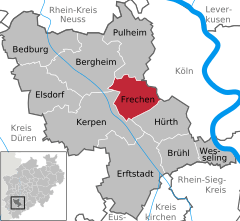Frechen
| Frechen | ||
|---|---|---|
|
Protestant church | ||
| ||
 Frechen | ||
Location of Frechen within Rhein-Erft-Kreis district 
 | ||
| Coordinates: 50°55′N 6°49′E / 50.917°N 6.817°ECoordinates: 50°55′N 6°49′E / 50.917°N 6.817°E | ||
| Country | Germany | |
| State | North Rhine-Westphalia | |
| Admin. region | Köln | |
| District | Rhein-Erft-Kreis | |
| Government | ||
| • Mayor | Hans-Willi Meier (CDU) | |
| Area | ||
| • Total | 45.11 km2 (17.42 sq mi) | |
| Population (2015-12-31)[1] | ||
| • Total | 51,999 | |
| • Density | 1,200/km2 (3,000/sq mi) | |
| Time zone | CET/CEST (UTC+1/+2) | |
| Postal codes | 50226 | |
| Dialling codes | 02234 | |
| Vehicle registration | BM | |
| Website | www.stadt-frechen.de | |
Frechen is a town in the Rhein-Erft-Kreis, in North Rhine-Westphalia, Germany. Frechen was first mentioned in 877. It is situated at the western Cologne city border.
It is the site of the 1257 Battle of Frechen between Conrad von Hochstaden, Archbishop of Cologne and the people of the town. In the 16th century it acquired a name for its terra cotta artifacts, especially the "Bartmannskrug" (beardman jug). In the late 18th century lignite was industrially mined. Digging for lignite dominated the city's economy until the end of the 20th century. In 1891 the first briquette factory was opened. On 2 September 1951 Frechen received its city-rights including the villages of Bachem, Hücheln and Buschbell. On 1 January 1975 the nearby villages of Grefrath, Habbelrath, Königsdorf and Neufreimersdorf were also incorporated.
As of December 31, 2015 there were 51,999 inhabitants registered.

Sons and daughters of the city
- Kirsten Bolm (born 1975), athlete
- Wayne Carpendale (born 1977), actor and presenter
- Pierre Vogel (born 1978), Islamist preacher
- Ayọ (born 1980, Joy Olasunmibo Ogunmakin ), soul singer
- Sonja Bertram (born 1984), actress
- Marcel Heller (born 1986), footballer
- Lennart Thy (born 1992), footballer
References
- ↑ "Amtliche Bevölkerungszahlen". Landesbetrieb Information und Technik NRW (in German). 18 July 2016.
External links
| Wikimedia Commons has media related to Frechen. |

